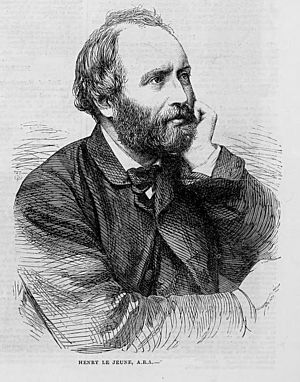Henry Lejeune facts for kids
Quick facts for kids
Henry Lejeune
|
|
|---|---|
 |
|
| Born | 12 December 1819 |
| Died | 5 October 1904 (aged 84) |
| Nationality | British |
| Known for | Painting; watercolour |
| Movement | Royal Academy |
Henry Le Jeune ARA (born December 12, 1819 – died October 5, 1904) was a talented English artist. He painted many different types of pictures. These included beautiful landscapes, scenes from everyday life (called genre), and stories from books or the Bible. He became especially famous for his paintings that showed children.
Contents
Life of Henry Le Jeune
Henry Le Jeune was born in London on December 12, 1819. His father, Anthony Le Jeune, was a musician. Henry was one of five children. He showed an early interest in art. His family encouraged him to visit the British Museum. There, he could study many famous art collections.
Becoming an Artist
In 1834, Henry Le Jeune was accepted into the Royal Academy of Arts. This was a very important art school. He was very good at art and won four silver medals in a row. In 1841, he won a gold medal. This was for his painting "Samson Bursting his Bonds," which was a biblical scene. He first showed his art at the Royal Academy in 1840. This painting was called "Joseph Interpreting the Dream of Pharaoh's Chief Butler."
Teaching and Recognition
From 1845 to 1848, Le Jeune taught at the Government School of Design. This school was located at Somerset House. Later, from 1848 to 1864, he worked at the Royal Academy. He was a curator and an instructor there. In 1863, he was chosen to be an Associate of the Royal Academy (ARA). This was a special honor for artists. He retired as an honorary associate in 1886.
Henry Le Jeune's Family Life
Henry Le Jeune married Dorothy Lewis on June 21, 1844. They had a large family with five sons and three daughters. He lived in London his whole life. He passed away in Hampstead in 1904. He was buried in Kensal Green Cemetery.
Henry Le Jeune's Artworks
Henry Le Jeune painted using both oil paints and watercolours. His paintings were shown in many places. He exhibited at the Royal Academy from 1840 to 1894. He also showed his art at the British Institution and other galleries.
Early Paintings
When he first started painting, Le Jeune often chose scenes from the Bible or famous books. He painted stories from Shakespeare and Spenser. Some of his early works include "The Infancy of Moses" (1842) and "Prospero and Miranda" (1844). He also painted "Ruth and Boaz" (1845) and "The Sermon on the Mount" (1845). In 1847, he painted "The Liberation of the Slaves." This painting was bought by Prince Albert himself!
Famous Genre Paintings
After the 1850s, Henry Le Jeune became very well known for his genre paintings. These are pictures that show everyday life. He was especially good at painting children. Some of his famous genre works include "Little Red Riding Hood" (1863). He also painted "Early Sorrow" (1869) and "Little Bo Peep" (1873 and 1881). Another well-known painting is "Much Ado About Nothing" (1873).
Where to See His Art
Today, you can find Henry Le Jeune's paintings in several art galleries across the United Kingdom. These include galleries in Wolverhampton and Liverpool.
Images for kids
-
The Eft (1862)


